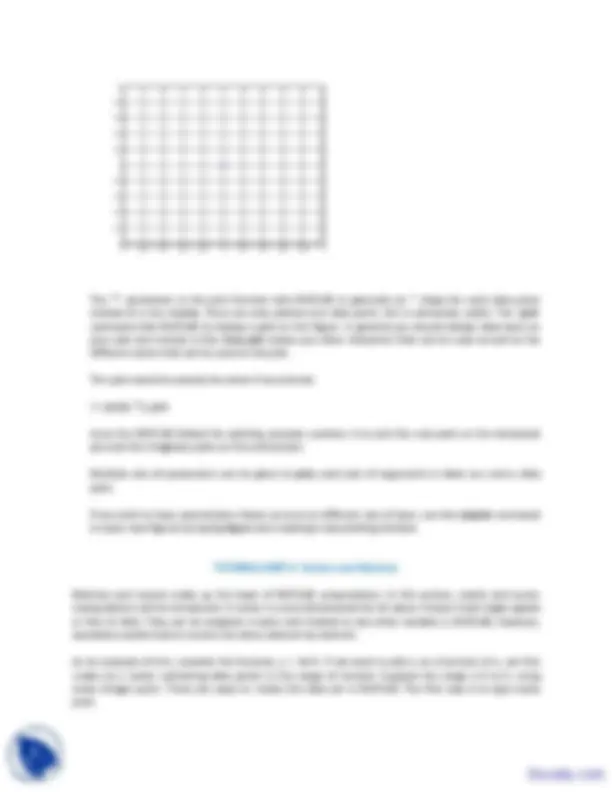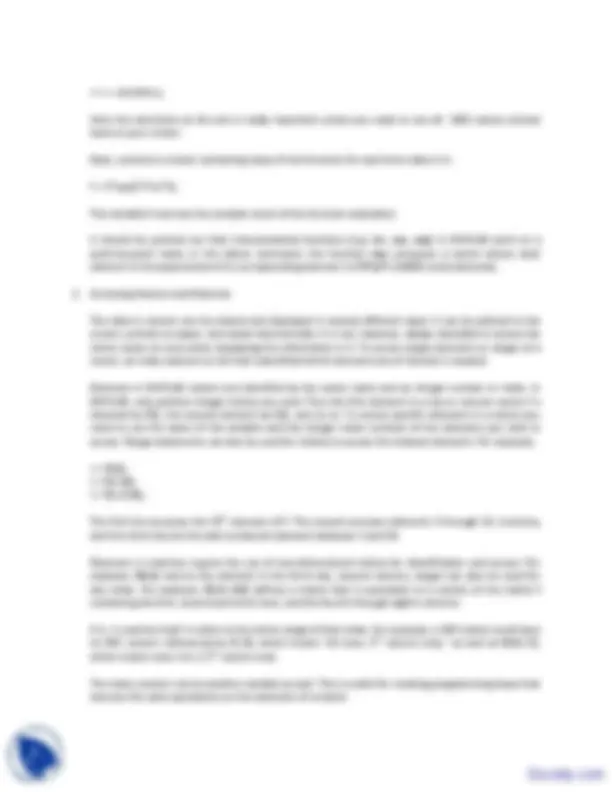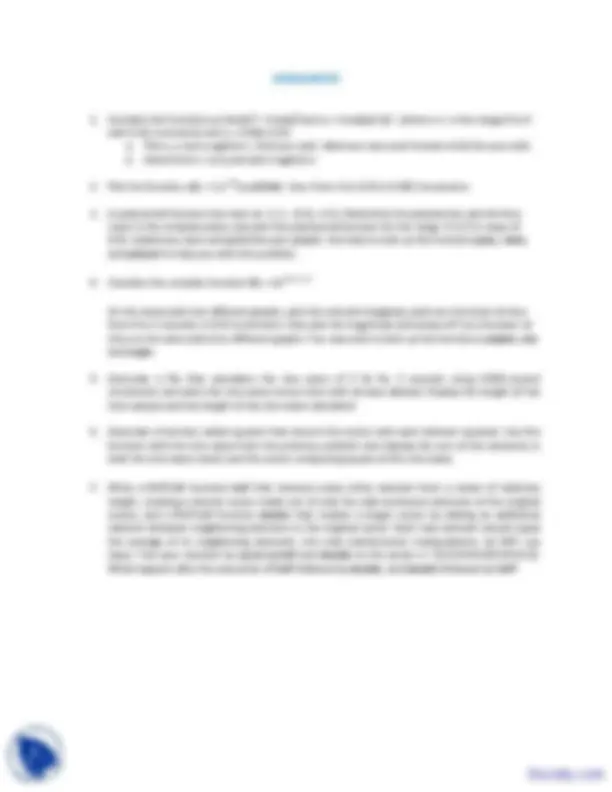






Study with the several resources on Docsity

Earn points by helping other students or get them with a premium plan


Prepare for your exams
Study with the several resources on Docsity

Earn points to download
Earn points by helping other students or get them with a premium plan
Community
Ask the community for help and clear up your study doubts
Discover the best universities in your country according to Docsity users
Free resources
Download our free guides on studying techniques, anxiety management strategies, and thesis advice from Docsity tutors
The Elements of Discrete Signal Analysis and the interactive internet programming with java, is very helpful series of lecture slides, which made programming an easy task. The major points in these laboratory assignment are:Evaluate Expressions, Algebra of Complex Numbers, Continuous Time Signals, Vector and Matrix Algebra, Command Window, Complex Variables and Expressions, Cartesian Form, Arithmetic Operations, Plot Function
Typology: Exercises
1 / 8

This page cannot be seen from the preview
Don't miss anything!





Laboratory Assignment 1
Purpose In this lab, you will be introduced to MATLAB by using it to evaluate expressions containing complex numbers. Using MATLAB, you can easily express these complex numbers in either rectangular or polar form. MATLAB’s plotting capabilities will be introduced and used extensively. You will also use M-files and create some simple signal processing functions that are used later in other lab assignments.
Objectives By the end of this laboratory assignment, you should be able to:
Reference Review Topics:
1. Starting MATLAB Start MATLAB by double (left) clicking on the MATLAB icon on the desktop of your computer. You will be working on the command window, and will enter all command after the prompt: >> 2. Evaluating Complex Variables and Expressions
In the following text, information that you enter will be preceded by the MATLAB prompt; information not preceded by a prompt is printed by MATLAB as a computation result or other information.
Problem 1:
Express each of the following complex numbers in Cartesian form, i.e., z = x+jy, where x = Re(z) and y = Im(z). Plot part (a) in the complex plane. a. Jej11π/ b. (1-j)^10
Part a: You can find the Cartesian form by typing the expression, using standard symbols for arithmetic operations.
jexp(j11*pi/4) ans = -0.7071 - 0.7071i
Note that MATLAB has evaluated the expression and echoed the result to the screen, expressed in Cartesian form as the variable ans. Also, just like any programming language, exp(x) returns ex. Other standard functions, including trigonometric functions, are available; type help elfun for a list. Additionally, pi is defined as a special variable having the value π, and j is defined as √(-1). Any special variable will act as defined until you change its value by assigning a new value to it. For example, to change pi to 3, issue the command
pi = 3 pi = 3 pi pi = 3 As you can see, pi has been changed. If you clear your definition, the old one reappears: clear pi pi ans =
Other variables can be set the same way. For instance, we can set z to the solution of part b:
z=(1-j)^ z = 0 -32.0000i
3. Plotting Complex-Valued Functions
Plots in MATLAB are generated using the plot function. Plot (x, y) generates a plot where the values of the vector x indicate points along the horizontal axis corresponding to the values in the vector y that are to be plotted on the vertical axis. Vectors x and y must have the same number of elements.
Since complex values have two components corresponding to x+jy , MATLAB provides the real and imag functions to separate the real and imaginary parts of a complex number:
z = 3+4j; zr = real(z); zi = imag(z);
real and imag break z into real and imaginary parts in the variables zr and zi, respectively.
Note that typing a semicolon at the end of the command prevents MATLAB from printing the result on your screen. This will be important when you create large matrices and vectors.
To plot a complex number, we can either plot the real parts vs. the imaginary parts or let MATLAB do it for us. Here, we supply zr and zi to the plot function:
plot(zr,zi,'*'); grid
and MATLAB generates the plot:
x = [0 1 2 3 4 5] x = 0 1 2 3 4 5 This generates a row vector x , i.e., a 1X6 matrix containing six elements, the integers 0 through 5. An easier way to generate this same vector is to use a range generating statement:
x = 0: x = 0 1 2 3 4 5
The colon operator acts like the word “to”, in effect generating the function “0 to 5’. A step size of 1 is the default. A different step size - positive, negative, real or integer - can be specified by placing the step value between the beginning and end of the range, as in k below:
k = 0:0.01:5;
which is a vector containing 501 data points that are 0.01 apart, starting from 0 and ending at 5.
Type help linspace to learn about another method to generate vectors in MATLAB.
The next step is to evaluate y , using x as defined above. y = 3*x+ y = 2 5 8 11 14 17
This statement instructs MATLAB to multiply every element in x by 3 and then add 2 to every element, storing the results in y. Thus 3* x is treated as a scalar multiplication of a vector and the 2 is implicitly treated as a vector of the same length as x comprising all 2s.
Note that when a dot precedes an operator, as using a .* for multiplication, it implies that each element in the vector (matrix) results from applying that operator to corresponding elements in the first and second vectors (matrices). For example, dot multiplication of two mX1 vectors results in an mX1 vector where each element is the product of the corresponding elements in the first and second vectors. Note that .* is the “dot product”, pr inner product operation from linear algebra. This type of multiplication requires that the vectors or matrices be of the same size and is called pointwise, rather than vector or matrix multiplication.
Since MATLAB is based on matrix operations, it is important to recall that you can only add or subtract matrices having the same dimensions, e.g., the addition of a 3X2 matrix to a 2X3 matrix is undefined. Matrix multiplication requires that the number of columns in the first matrix be the same as the number of rows in the second matrix. For example, multiplication of a 2X5 matrix A and a 5X3 matrix B results in a 2X3 matrix C=AB , whereas the multiplication BA is undefined. However, the multiplication D = B’A is defined, where ‘ denotes the transpose operation in MATLAB.
Let’s generate values for the complex function f(t) = 3ej3πt^ for t ranging from 0 to 1 in 0. increments. The first step is to create a time variable.
t = 0:0.001:1;
Here the semicolon at the end is really important unless you want to see all 1001 values echoed back on your screen.
Next, construct a vector containing value of this function for each time value in t :
f = 3exp(j3pit);
The variable f now has the complex result of the function evaluation.
It should be pointed out that transcendental functions (e.g. sin , cos , exp ) in MATLAB work on a point-by-point basis; in the above command, the function exp computes a vector where each element is the exponential of its corresponding element in j3pit* (10001 total elements).
The data in vectors can be viewed and displayed in several different ways: it can be plotted to the screen, printed on paper, and saved electronically. It is not, however, always desirable to access the entire vector at once when displaying the information in it. To access single elements or ranges of a vector, an index element or list that indentified which elements are of interest is needed.
Elements in MATLAB vectors are identified by the vector name and an integer number or index. In MATLAB, only positive integer indices are used. Thus the first element in a row or column vector f is denoted by f(1), the second element by f(2), and so on. To access specific elements in a vector you need to use the name of the variable and the integer index numbers of the elements you wish to access. Range statements can also be used for indices to access the indexed elements. For example,
f(25); f(3:10); f(1:2:50);
The first line accesses the 25th^ element of f. The second accesses elements 3 through 10, inclusive; and the third returns the odd numbered elements between 1 and 50.
Elements in matrices require the use of two-dimensional indices for identification and access. For example, f(3,2) returns the element in the third row, second column; ranges can also be used for any index. For example, f(1:3, 4:8) defines a matrix that is equivalent to a section of the matrix f containing the first, second and third rows, and the fourth through eighth columns.
If a : is used by itself, it refers to the entire range of that index. For example, a 3X5 matrix could have its fifth column referenced by f(:,5) , which means “all rows, 5th^ column only,” as well as f(1:3, 5) , which means rows 1 to 3, 5th^ column only.
The index number can be another variable as well. This is useful for creating programming loops that execute the same operations on the elements of a matrix.
Creation of a Function in MATLAB
A function in MATLAB is a special kind of M-file. The first line defines the function, both giving it a name and indicating what values are to be passed as arguments to the function and those that are to be generated by the function. Once you have created a function, you can use it as you would any built-in function in MATLAB, such as help or plot.
A Useful feature of function files is that the lines that follow the function definition and begin with a comment symbol (%) are printed when help is requested for your function ( help yourfunction prints these lines).
Make a function that takes two variables as arguments, adds 1 to the first variable, multiplies the second variable by two and returns the product of the two variables. This function is called blackbox. The file is called balckbox.m
Solution:
function [output] = blackbox(a,b) %Adds 1 to argument a and multiplies b by 2 % Returns the product of a nd b in output % % if the two variables are not if the same size %the larger variable is stripped to be the same size as the smaller
%Detremine the lengths of each vector la = length(a); lb = length(b);
%Add 1 to a a = a+1;
%Multiply b by 2 b = b*2;
%Compare the lengths; truncate the longer vector if la < lb output = a.b(a:la); else output = a(1:lb).b; end
The elements in this file that are required in order for MATLAB to recognize it as a valid function are:
On the same plots but different graphs, plot the real and imaginary parts as a function of time from 0 to 3 seconds in 0.01 increments. Also plot the magnitude and phase of f as a function of time on the same plots but different graphs. You may wish to look up the functions subplot, abs and angle.